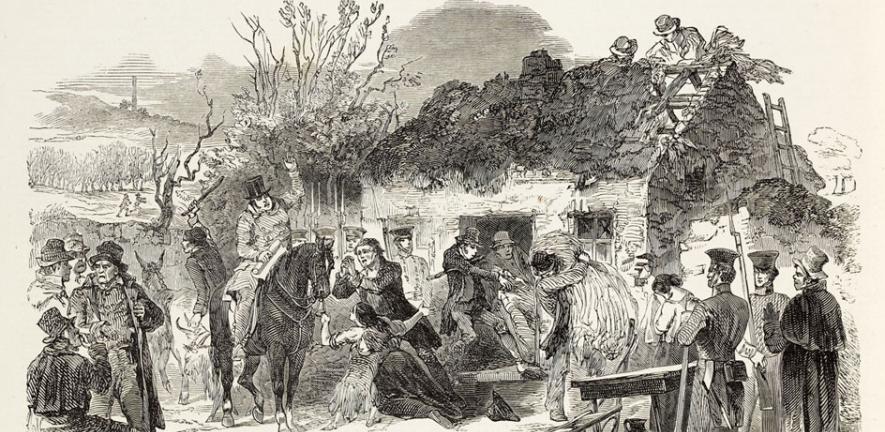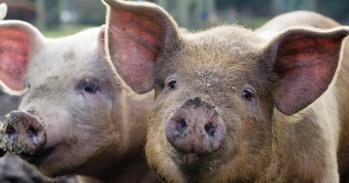
A new book by a Cambridge University academic revisits one of the worst famines in recorded history. The Irish Famine of the 1840s had terrible consequences: 1 million people died and several million left Ireland. Today the world is watching as millions in Africa face a similar fate: starvation in the midst of plenty. Dr David Nally’s analysis of what happened in his native Ireland less than two centuries ago reveals some shocking parallels with what is happening in Africa.
A new book by a Cambridge University academic revisits one of the worst famines in recorded history. The Irish Famine of the 1840s had terrible consequences: 1 million people died and several million left Ireland. Today the world is watching as millions in Africa face a similar fate: starvation in the midst of plenty. Dr David Nally’s analysis of what happened in his native Ireland less than two centuries ago reveals some shocking parallels with what is happening in Africa.
This tendency to ‘blame the victim’, as it has been described, allows rulers and élites to ignore the deeper injustices that expose populations to calamities – making disasters like famine more likely to occur in the first place.
Dr David Nally
In the Horn of Africa a humanitarian disaster is fast unfolding with the spectre of famine looming. The worst drought for 60 years means that crops have failed and livestock has perished, leaving impoverished communities increasingly vulnerable to malnutrition and hunger-related diseases. Poverty, climate change and rising grain prices are combining to tip an already vulnerable population into a state of crisis.
An estimated 10 million people are affected across a vast swathe of Africa taking in areas of Somalia, Ethiopia, Kenya and Uganda. Huge numbers of people are on the move, leaving their homes and walking hundreds of miles to seek food in camps and feeding stations. Harrowing media reports describe mothers having to choose between seeking medical treatment for their weakest child and nourishment for the others. They live in a situation in which their everyday decisions have the most extraordinary consequences.
Fewer than 170 years ago, a similarly terrible famine occurred within the British Isles, then the most economically advanced region in the world. In Ireland, at that time part of the UK as a result of the Act of Union in 1801, 1 million people perished in what became known as An Gorta Mór or The Great Hunger. There was not one food crisis but several as the potato crop failed in 1845, 1846, 1848 and 1849. The rural Irish poor, many of whom were subsistence farmers renting small plots of ground, were reliant on the potato for their staple diet.
When a mysterious blight, now known as Phytophthora infestans, destroyed the potato harvest huge numbers faced starvation. Millions of people fled the country with the population of Ireland dwindling from around 9 million in 1845 to 6.1 million in 1851. The tide of emigration continued to swell long after the harvest failures: in 1866 Ireland’s population was roughly equivalent to its 1801 figure of 5.5 million. In comparative terms, the Great Irish Famine was one of the worst demographic tragedies of the 19th century and possibly the worst famine in recorded history when judged in terms of the mortality rate.
In Human Encumbrances: Political Violence and the Great Irish Famine, Dr Nally examines the complexities and nuances of the political, economic and social context of the Irish Famine - and in doing so throws up some disturbing parallels between what happened in the 1840s and what is happening in Africa today. In particular, the book looks at 19th-century sources to shine a light on the dialogue, sometimes taking the form of heated exchanges, that went on between economists, politicians and public officials.
By studying archives of contemporary material, Nally analyses the fundamental human perceptions that shaped political decision-making and had a direct bearing on the lives of millions of poor farmers. Many of these discourses are as topical and controversial today as they were almost two centuries ago, centring on the ethics of free markets and non-intervention versus intervention in the form of government aid.
Nally’s book borrows its title from a pamphlet written by the maverick English MP, George Poulett Scrope (1797-1876). In a scathing critique of British policies in Ireland, Poulett Scrope claimed that the Irish were being treated as mere “human encumbrances”, biological impediments to the long march of progress and agricultural development that characterised European modernity. This description neatly sums up the perception of the Irish smallholders as expendable, and their way of life as backward, immoral and in urgent need of reform. Poverty was associated with idleness, lack of intelligence, and improvidence.
Contemporary reports established distinctions at every level, between ruler and ruled, the ‘deserving’ and ‘undeserving,’ the indolent and the industrious. Even the very diets that the people relied on were viewed in moral terms: the feckless and slothful Irish were potato-fed, whereas the thrifty and hard-working English were wheat-fed.
“In terms of perceptions,” comments Nally, “not much has changed since the 19th century. Dominant economic institutions like the World Bank still consider poverty in the Global South in much the same way as the Victorians judged the Irish: the natives are fundamentally incapable of autonomous development and, in certain situations, corrective measures will be needed to stimulate social reform and promote agricultural development.
This tendency to ‘blame the victim’, as it has been described, allows rulers and élites to ignore the deeper injustices that expose populations to calamities – making disasters like famine more likely to occur in the first place – and to leave untouched the political and economic arrangements from which they clearly benefit. You could say that we are blinded by an ideology of poverty that the Victorians bequeathed to us.”
A key phrase in Nally's book is “structural violence”: a term used to describe how certain institutional arrangements can render entire communities vulnerable to famine and at the same time impede alternative reforms that nurture local resiliencies. For Nally, the current emphasis on increasing food production through market integration and technological fixes, ignores the well-established fact that there is enough food to feed the world's present population - in fact recent estimates suggest that there is 20 per cent more food than the world needs. The relationship between food supply and starvation has long been a contentious issue and the Irish Famine is no exception. Contemporary accounts describe ships carrying relief from England passing ships sailing out of Ireland with cargos of wheat and beef to be sold for prices out of reach to the starving population.
“In the analogous way,” Nally suggests, “Africa, a land synonymous with disease and starvation, is a major supplier of raw materials including diamonds, gold, oil, timber, food and biofuels that underpin the affluence of Western societies. The current focus on food availability and supply effectively masks how resources are unevenly distributed and consumed.”
As Nally’s research shows, famines not only destroy lives but very often whole ways of life. The culture and language of the Irish people were ‘silent’ victims of the Famine. In 1800 half of the population conversed in Irish; at the turn of the 20th century that figure had been reduced to a mere 14 per cent. Evidence collected in the Irish Folk Archive alludes to the disruption of rural social relations, and in particular, an ethic of care that was thought to characterise pre-Famine modes of living.
In the wake of the Great Hunger, the Irishman Hugh Dorian described his native Donegal as a place “where friendship was forgotten and men lived as if they dreaded one another”. Such descriptions stand in contrast to accounts of middle class farmers (and some English and Scottish settlers) who gained land and power as a result of the dispossession of smallholders.
“Famines leave behind a tense landscape of ‘winners’ and ‘losers’. We ought to be honest about the fact,” continues Nally, “that life and death decisions are woven into the texture of economic relations. Hunger persists because its presence serves an important function in the global economy: scarcity and abundance, privilege and suffering, are in fact mutually constituted.
"To tackle global hunger we must therefore address the legal and institutional structures that directly restrict certain people’s ability to subsist. The reason that this is not done is because these same structures guarantee the high standard of living that many of us have become accustomed to.”
As several observers of Irish events recognised, hunger is not a natural disaster: it is a human-induced problem that demands political solutions. According to Nally, effective solutions will require joined-up thinking.
“At present, the problem of ‘food insecurity’ – to adopt the modern, sanitised term for widespread starvation – is generally conceptualised as a scientific and technical matter: geneticists and plant scientists will engineer harvests that produce more efficient, more abundant crops that are more tolerant of climatic stress, more resistant to attacks by pathogens, and so on. This, we are told, will be the basis for ending global hunger. While the physical sciences do have an important role to play, it is wishful thinking to believe that hunger can be avoided by simply ‘turbocharging’ nature – that we can, if you like, engineer our way out of scarcity,” he argues.
The food activist and writer Frances Moore Lappé maintains that the real scarcity we face is one of democracy, not food. Nally insists that there is an important truth to that statement, which is routinely ignored.
“One is reminded of the French writer Guy de Maupassant who apparently used to take his daily lunch at the Eiffel Tower because it was the only place in Paris where he did not have to look at the imposing structure. We are behaving a bit like Maupassant: we can continue to enjoy ‘lunch as normal’ as long as we maintain the fiction that hides us from the ugly truth that is otherwise staring us in the face.”
This work is licensed under a Creative Commons Licence. If you use this content on your site please link back to this page.





